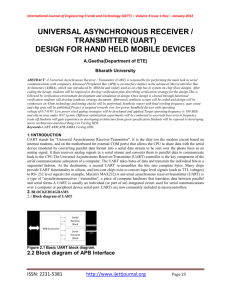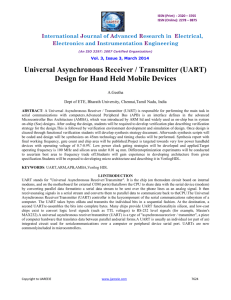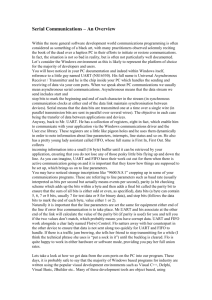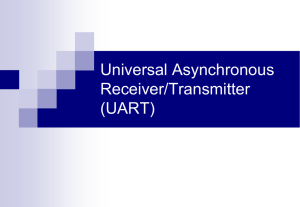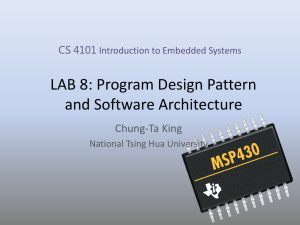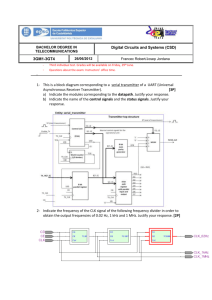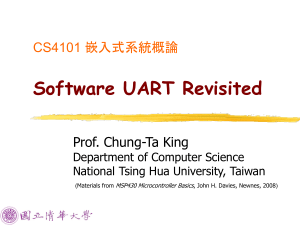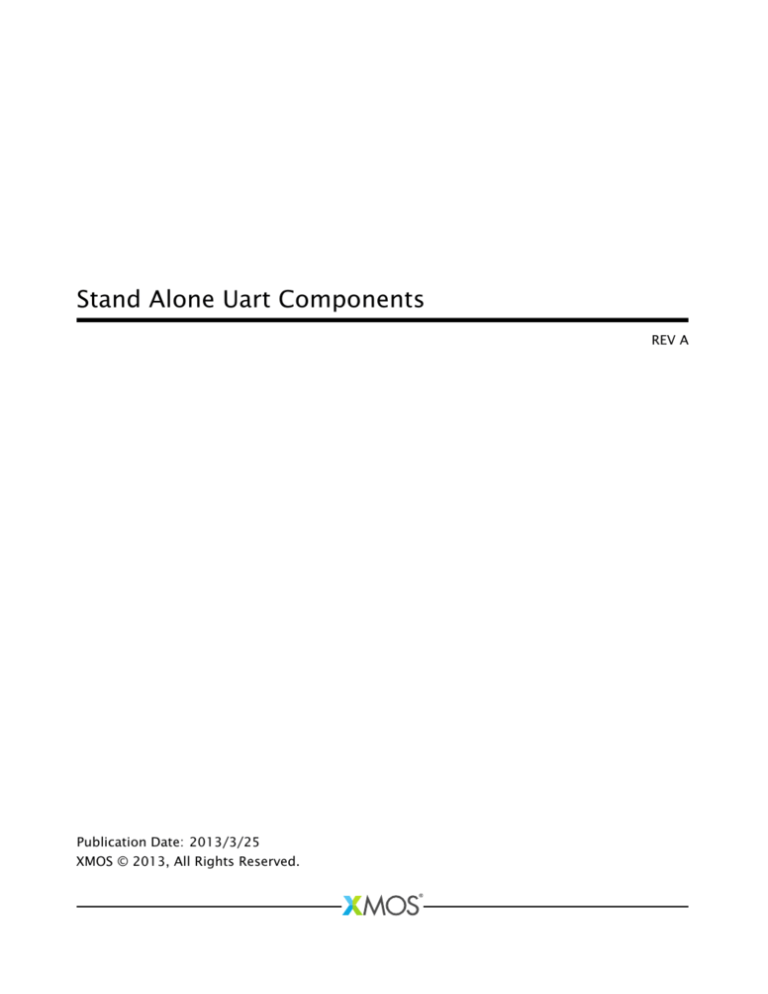
Stand Alone Uart Components
REV A
Publication Date: 2013/3/25
XMOS © 2013, All Rights Reserved.
Stand Alone Uart Components
2/14
Table of Contents
1 Overview
1.1 Uart Modules .
1.2 Generic UART
1.3 Simple Uart . .
1.4 Other Uarts . .
.
.
.
.
.
.
.
.
.
.
.
.
.
.
.
.
.
.
.
.
.
.
.
.
.
.
.
.
.
.
.
.
.
.
.
.
.
.
.
.
3
3
3
4
4
.
.
.
.
.
.
.
.
.
.
.
.
.
.
.
.
.
.
.
.
.
.
.
.
.
.
.
.
.
.
.
.
.
.
.
.
.
.
.
.
.
.
.
.
.
.
.
.
.
.
.
.
.
.
.
.
.
.
.
.
.
.
.
.
.
.
.
.
.
.
.
.
.
.
.
.
.
.
.
.
.
.
.
.
.
.
.
.
.
.
.
.
.
.
.
.
.
.
.
.
.
.
.
.
.
.
.
.
.
.
.
.
.
.
.
.
.
.
.
.
2 Generic UART
2.1 Resource Requirements . . . . . . .
2.2 Evaluation Platforms . . . . . . . .
2.2.1 Recommended Hardware .
2.2.2 Demonstration Application
2.3 API and Programming Guide . . . .
2.3.1 Key Files . . . . . . . . . . .
2.3.2 TX API . . . . . . . . . . . . .
2.3.3 RX API . . . . . . . . . . . . .
2.4 Example Applications . . . . . . . .
2.4.1 GPIO Slice Examples . . . .
2.4.2 Basic Loopback Example . .
.
.
.
.
.
.
.
.
.
.
.
.
.
.
.
.
.
.
.
.
.
.
.
.
.
.
.
.
.
.
.
.
.
.
.
.
.
.
.
.
.
.
.
.
.
.
.
.
.
.
.
.
.
.
.
.
.
.
.
.
.
.
.
.
.
.
.
.
.
.
.
.
.
.
.
.
.
.
.
.
.
.
.
.
.
.
.
.
.
.
.
.
.
.
.
.
.
.
.
.
.
.
.
.
.
.
.
.
.
.
.
.
.
.
.
.
.
.
.
.
.
.
.
.
.
.
.
.
.
.
.
.
.
.
.
.
.
.
.
.
.
.
.
.
.
.
.
.
.
.
.
.
.
.
.
.
.
.
.
.
.
.
.
.
.
.
.
.
.
.
.
.
.
.
.
.
.
.
.
.
.
.
.
.
.
.
.
.
.
.
.
.
.
.
.
.
.
.
.
.
.
.
.
.
.
.
.
.
.
.
.
.
.
.
.
.
.
.
.
.
.
.
.
.
.
.
.
.
.
.
.
.
.
.
.
.
.
.
.
.
.
.
.
.
.
.
.
.
.
.
.
.
.
.
.
.
.
.
.
.
.
.
.
.
.
.
.
.
.
.
.
.
.
.
.
.
.
.
.
.
.
.
.
.
.
.
.
.
.
.
.
.
.
.
.
.
.
.
.
.
.
.
.
.
.
.
.
.
5
. 5
. 5
. 5
. 6
. 6
. 6
. 6
. 8
. 10
. 10
. 10
3 Simple UART
3.1 Resource Requirements . . . . . . .
3.2 Evaluation Platforms . . . . . . . .
3.2.1 Recommended Hardware .
3.2.2 Demonstration Application
3.3 API and Programming Guide . . . .
3.3.1 API . . . . . . . . . . . . . .
3.3.2 Example Usage . . . . . . .
3.4 Example Application . . . . . . . .
.
.
.
.
.
.
.
.
.
.
.
.
.
.
.
.
.
.
.
.
.
.
.
.
.
.
.
.
.
.
.
.
.
.
.
.
.
.
.
.
.
.
.
.
.
.
.
.
.
.
.
.
.
.
.
.
.
.
.
.
.
.
.
.
.
.
.
.
.
.
.
.
.
.
.
.
.
.
.
.
.
.
.
.
.
.
.
.
.
.
.
.
.
.
.
.
.
.
.
.
.
.
.
.
.
.
.
.
.
.
.
.
.
.
.
.
.
.
.
.
.
.
.
.
.
.
.
.
.
.
.
.
.
.
.
.
.
.
.
.
.
.
.
.
.
.
.
.
.
.
.
.
.
.
.
.
.
.
.
.
.
.
.
.
.
.
.
.
.
.
.
.
.
.
.
.
.
.
.
.
.
.
.
.
.
.
.
.
.
.
.
.
.
.
.
.
.
.
.
.
.
.
.
.
.
.
.
.
.
.
.
.
.
.
.
.
.
.
.
.
.
.
.
.
.
.
.
.
.
.
.
.
REV A
.
.
.
.
11
11
11
11
11
12
12
12
13
1 Overview
IN THIS CHAPTER
· Uart Modules
· Generic UART
· Simple Uart
· Other Uarts
UART is one of the most basic asynchronous communication protocols. Also known
as RS-232, it transmits bits serially at a mutually agreed speed without providing a
clock. The speed is known as the baud rate, and is typically something like 9600
baud, 115200 baud, or 10 Mbaud.
The most important characteristics are the following:
· The baud rate.
· The number of start bits, typically 1, sometimes 1.5
· The number of data bits, typically 7 or 8
· Whether a parity bit is present, and if so whether it is even parity or odd parity
· The number of stop bits, typically 1, sometimes 2.
1.1
Uart Modules
Four uart modules are covered by this document, as shown below.
Component
Generic UART
Simple UART
modules
Data rate
Memory
module_uart_tx
to 115.2K ~1K
module_uart_rx
to 115.2K ~1K
module_uart_fast_tx
10 Mbaud 0.25K
module_uart_fast_tx
10 Mbaud
1.2
0.25K
Parity
Even/Odd/None
Even/Odd/None
None
Bits Per Byte
5/6/7/8
5/6/7/8
8
Stop Bits
1 or 2
1 or 2
1
None
8
1
Generic UART
This module is completely parameterisable at run time and will require a logical
core for each of RX and TX. Unlike the simple uart below, it can operate at the
standard UART baud rates.
REV A
Stand Alone Uart Components
1.3
4/14
Simple Uart
This module is a much simpler implementation of a UART that will require a whole
logical core for RX and deliver up to 10 Mbaud. TX could be called as a function,
and hence share a logical core with other functionality although this will affect the
TX baud rate achieved,and this usage is not shown.
It is fixed to 8 bits, a single start bit, no parity, and a single stop bit. All of those
parameters could be changed by altering the source code.
The baud rate is parameterisable, but has to be a whole division of 100 MHz. This
may make it unsuitable for some applications requiring a very particular baud rate.
Note that the code is easy to understand; it comprises the example from the XC
programming manual.
1.4
Other Uarts
For an implementation of multi-uart suitable for applications where more than one
uart is required, the module_multi_uart component may be a better choice, which
offers up t 8 uarts in two logical cores. In general, designs requring a single basic
uarts are often most optimally constructed by incorporating the TX functionality
inline with other application functions, and having a separate logical core for RX. A
fully optimised design incorporating uarts may therefore merit some modifications
of these components.
REV A
2 Generic UART
IN THIS CHAPTER
· Resource Requirements
· Evaluation Platforms
· API and Programming Guide
· Example Applications
This UART has two modules, one for RX and one for TX each of which uses one logical core and is
connected via channel to another logical core using the UART Client API .
The logical core for the UART TX component receives data from the client via a buffer (configurable
between 1 and 64 bytes). A full buffer will block the client.
The logical core for the UART RX component receives data from external into the RX buffer
(configurable between 1 and 64 bytes) which is read by the client using channel. An empty RX
buffer will block the client.
2.1
Resource Requirements
A single generic uart consisting of module_uart_rx and module_uart_tx will consumer the following
resources:
2.2
2.2.1
Resource
Usage
Code Memory
Ports
ChannelEnds
2110
2 x 1b
2
Evaluation Platforms
Recommended Hardware
This module may be evaluated using the Slicekit Modular Development Platform, available from
digikey. Required board SKUs are:
· XP-SKC-L2 (Slicekit L2 Core Board) plus XA-SK-GPIO plus XA-SK-ATAG2 (Slicekit XTAG adaptor)
plus XTAG2 (debug adaptor), OR
· XK-SK-L2-ST (Slicekit Starter Kit, containing all of the above).
REV A
Stand Alone Uart Components
2.2.2
6/14
Demonstration Application
Example usage of this module can be found within the XSoftIP suite as follows:
· Package: sw_gpio_examples
· Application: app_slicekit_com_demo
· Package: sc_uart
· Application: app_uart_back2back
2.3
2.3.1
API and Programming Guide
Key Files
File
module_uart_tx/src/uart_tx.h
module_uart_tx/src/uart_tx.xc
module_uart_tx/src/uart_tx_impl.h
module_uart_tx/src/uart_tx_impl.xc
module_uart_rx/src/uart_rx.h
module_uart_rx/src/uart_rx.xc
module_uart_rx/src/uart_rx_impl.h
module_uart_rx/src/uart_rx_impl.xc
2.3.2
Description
Client API header file for Generic UART TX
Client API implementation for Generic UART TX
UART TX Server Header File
UART TX Server implementation
Client API header file for Generic UART RX
Client API implementation for Generic UART RX
UART RX Server Header File
UART RX Server implementation
TX API
The UART TX component is started using the uart_tx() function, which causes the TX server (called
“_impl” in the code) to run in a while(1) loop until it receives and instruction to shut down via
the channel from the client. Additionally a set of client functions are provided to transmit a byte
and to alter the baud rate, parity, bits per byte and stop bit settings. Any such action except
transmitting a byte causes the TX server to terminate and then be restarted with the new settings.
Any data in the TX buffer is preserved and then sent with the new settings.
void uart_tx(out port txd,
unsigned char buffer[],
unsigned buffer_size,
unsigned baud_rate,
unsigned bits,
enum uart_tx_parity parity,
unsigned stop_bits,
chanend c)
UART TX server function.
This function never returns and the arguments specify the initial configuration
of parity, bits per byte etc. These are checked and then the inner UART TX
REV A
Stand Alone Uart Components
7/14
loop (uart_tx_impl() is started and runs in a while(1) loop until it receives and
instruction to shut down via the channel from the client. Additionally a set of client
functions are provided to transmit a byte and to alter the baud rate, parity, bits
per byte and stop bit settings. Note that the buffer size can only be changed when
this function is first called, it cannot be changed thereafter.
The client provides data to the server using the send byte function below.
Arguments are as follows:
This function has the following parameters:
txd
Transmitted data signal. Must be a 1-bit port.
buffer
Array for buffering bytes before they are transmitted.
buffer_size
Size of the buffer array.
baud_rate
Initial baud rate.
bits
Initial bits per character. Must be less than 8.
parity
Type of parity to initially use.
UART_TX_PARITY_NONE is passed.
stop_bits
Initial number of stop bits to transmit.
c
Chanend to receive requests on, where a request is either a byte to
transmit or a configuration change.
No parity bit is transmitted if
void uart_tx_send_byte(chanend c, unsigned char byte)
Adds a byte into the UART transmit buffer.
If the the buffer is full then this function blocks until there is room in the buffer.
This function has the following parameters:
c
Other end of the channel passed to the uart_tx() function.
byte
Byte to transmit.
void uart_tx_set_baud_rate(chanend c, unsigned baud_rate)
Set the baud rate of the of the UART TX server.
The change of configuration takes effect after all remaining data in transmit buffer
is sent, and the function blocks until the change of configuration takes effect.
This function has the following parameters:
REV A
c
Other end of the channel passed to the uart_tx() function.
baud_rate
The baud rate setting.
Stand Alone Uart Components
8/14
void uart_tx_set_parity(chanend c, enum uart_tx_parity parity)
Set the parity of the of the UART TX stop bit.
The change of configuration takes effect after all remaining data in transmit buffer
is sent, and the function blocks until the change of configuration takes effect.
This function has the following parameters:
c
Other end of the channel passed to the uart_tx() function.
parity
The parity setting. Note parity is an enum.
void uart_tx_set_stop_bits(chanend c, unsigned stop_bits)
Set the number of stop bits used by the UART TX server.
The change of configuration takes effect after all remaining data in transmit buffer
is sent, and the function blocks until the change of configuration takes effect.
This function has the following parameters:
c
Other end of the channel passed to the uart_tx() function.
stop_bits
The stop bits or bits-per-byte setting. Note parity is an enum.
void uart_tx_set_bits_per_byte(chanend c, unsigned bits)
Set the bits per byte rate of the of the UART TX server.
The change of configuration takes effect after all remaining data in transmit buffer
is sent, and the function blocks until the change of configuration takes effect.
This function has the following parameters:
2.3.3
c
Other end of the channel passed to the uart_tx() function.
bits
The bits or bits-per-byte setting.
RX API
The UART RX component is started using the uart_tx() function, which causes the TX server (called
“_impl” in the code) to run in a while(1) loop until it receives and instruction to shut down via the
channel from the client. Additionally a set of client functions are provided to fetch a byte from
teh recieve buffer and to alter the baud rate, parity, bits per byte and stop bit settings. Any such
action except transmitting a byte causes the RX server to terminate, the receive buffer emptied,
and then restarted immediately with the new settings.
void uart_rx(in buffered port:1 rxd,
unsigned char buffer[],
unsigned buffer_size,
unsigned baud_rate,
unsigned bits,
enum uart_rx_parity parity,
REV A
Stand Alone Uart Components
9/14
unsigned stop_bits,
chanend c)
UART RX server function.
The client must call the uart_rx_init() function to initialize the server before
calling any other client functions. Bytes received by the server are buffered in
the buffer array. When the buffer is full further incoming bytes of data will be
dropped.
This function never returns, and will start the server RX inner loop which runs in a
while(1) loop until it is stopped via a command over channelend, following whcih
the inner loop is automatyically restarted.
The functions below are provided to change the UART RX parameters, parity, bitsper-byte, stop bits and baud rate, and all of these cause the RX inner loop to
terminate while the new settings are applied. Bytes received during this time would
be dropped, and any receive buffer contents are discarded when the settings are
changed. Note that the buffer size can only be changed when this function is first
called, it cannot be changed thereafter.
The client uses uart_rx_get_byte() to get bytes from the receive buffer.
unsigned char uart_rx_get_byte(chanend c, uart_rx_client_state &state)
Get a byte from the receive buffer.
This function blocks until there is a byte available.
void uart_rx_get_byte_byref(chanend c,
uart_rx_client_state &state,
unsigned char &byte)
void uart_rx_set_baud_rate(chanend c,
uart_rx_client_state &state,
unsigned baud_rate)
Set the baud rate of the UART RX server.
The change of configuration takes place immediately.
void uart_rx_set_parity(chanend c,
uart_rx_client_state &state,
enum uart_rx_parity parity)
Set the parity of the UART RX server.
The change of configuration takes place immediately.
void uart_rx_set_stop_bits(chanend c,
uart_rx_client_state &state,
unsigned stop_bits)
REV A
Stand Alone Uart Components
10/14
Set number of stop bits used by the UART RX server.
The change of configuration takes place immediately.
void uart_rx_set_bits_per_byte(chanend c,
uart_rx_client_state &state,
unsigned bits)
Set number of bits per byte used by the UART RX server.
The change of configuration takes place immediately.
2.4
2.4.1
Example Applications
GPIO Slice Examples
This uart is used in the GPIO Com Port Demo demo application to transfer commands from a host
computer via uart to light the LEDs and read the adc on the Slicekit GPIO Slice Card. Refer to this
item in xTIMEcomposer for more details on running this example application.
2.4.2
Basic Loopback Example
These modules can also be evaluated wired back to back using app_uart_back2back. To prepare
the Slicekit core board to run this app connect wires between the 0.1” testpoints on the Triangle
slot (or solder suitable headers on as shown in the picture below), such that ports 1A and 1E are
connected. The headers corresponding to these ports are marked D0 and D12 respectively.
The app can then be built and run.
It will send the full set of characters from the UART TX, receive them on UART RX and then print
them out in batches of 10 characters.
REV A
3 Simple UART
IN THIS CHAPTER
· Resource Requirements
· Evaluation Platforms
· API and Programming Guide
· Example Application
The intention of this module is to implement a high speed uart, at the expense of logical cores
and 1-bit ports. Other modules provide lower-speed uarts that are logical core-efficient, or that
may use fewer 1-bit ports. This module will support a 10 Mbaud rate with 100 MIPS logical cores,
and correspondingly less with lower MIPS per logical core.
3.1
3.2
3.2.1
Resource Requirements
Resource
Usage
Code Memory
Ports
ChannelEnds
Logical Cores
2110
2 x 1b
2
2
Evaluation Platforms
Recommended Hardware
This module may be evaluated using the Slicekit Modular Development Platform, available from
digikey. Required board SKUs are:
· XP-SKC-L2 (Slicekit L2 Core Board) plus XA-SK-XTAG2 (Slicekit XTAG adaptor) plus XTAG2 (debug
adaptor), OR
· XK-SK-L2-ST (Slicekit Starter Kit, containing all of the above).
3.2.2
Demonstration Application
Example usage of this module can be found within the XSoftIP suite as follows:
· Package: sc_uart
· Application: app_uart_fast
REV A
Stand Alone Uart Components
3.3
3.3.1
12/14
API and Programming Guide
API
void uart_rx_fast(in port p, streaming chanend c, int clocks)
This function implements a fast UART.
It needs an unbuffered 1-bit port, a streaming channel end, and a number of
port-clocks to wait between bits. It receives a start bit, 8 bits, and a stop bit, and
transmits the 8 bits over the streaming channel end as a single token. On a 62.5
MIPS thread this function should be able to keep up with a 10 MBit UART sustained
(provided that the streaming channel can keep up with it too).
This function does not return.
This function has the following parameters:
p
input port, 1 bit port on which data comes in
c
output streaming channel - read bytes of this channel (or words if
you want to read 4 bytes at a time)
clocks
number of clock ticks between bits. This number depends on the
clock that you have attached to port p; assuming it is the standard
100 Mhz reference clock then clocks should be at least 10.
void uart_tx_fast(out port p, streaming chanend c, int clocks)
This function implements a fast UART.
It needs an unbuffered 1-bit port, a streaming channel end, and a number of
port-clocks to wait between bits. It waits for a token on the streaming channel,
and then sends a start bit, 8 bits, and a stop bit. On a 62.5 MIPS thread this
function should be able to keep up with a 10 MBit UART sustained (provided that
the streaming channel can keep up with it too).
This function does not return.
This function has the following parameters:
3.3.2
p
output port, 1 bit port on which data should be transmitted
c
input streaming channel - output bytes of this channel (or words if
you want to output 4 bytes at a time)
clocks
number of clock ticks between bits. This number depends on the
clock that you have attached to port p; assuming it is the standard
100 Mhz reference clock then clocks should be at least 10.
Example Usage
Declare ports (and clock blocks if you do not want to run the ports of the reference clock):
REV A
Stand Alone Uart Components
13/14
clock refClk = XS1_CL KBLK_R EF ;
in port rx = XS1_PORT_1A ;
out port tx = XS1_PORT_1B ;
A function that produces data (just bytes 0..255 in this example)
void produce ( streaming chanend c ) {
for ( int i = 0; i < 256; i ++) {
c <: ( unsigned char ) i ;
}
}
A function that consumes data (and in this example throws it away)
void consume ( streaming chanend c ) {
unsigned char buf [256];
unsigned char foo ;
for ( int i = 0; i < 256; i ++) {
c : > buf [ i ];
}
for ( int i = 0; i < 256; i ++) {
printhexln ( buf [ i ]) ;
}
}
A main par that starts the logical cores:
int main ( void ) {
streaming chan c , d ;
c o n f i g u r e _ o u t _ p o r t _ n o _ r e a d y ( tx , refClk , 1) ;
c o n f i g u r e _ i n _ p o r t _ n o _ r e a d y ( rx , refClk ) ;
clearbuf ( rx ) ;
par {
produce ( d ) ;
consume ( c ) ;
uart_tx_fast ( tx , d , 10) ;
uart_rx_fast ( rx , c , 10) ;
}
}
3.4
Example Application
These modules can be evaluated wired back to back using app_uart_fast. To prepare the Slicekit
core board to run this app connect wires between the 0.1” testpoints on the Triangle slot (or solder
suitable headers on as shown in the picture below), such that ports 1A and 1E are connected. The
headers corresponding to these ports are marked D0 and D12 respectively.
REV A
Stand Alone Uart Components
14/14
The app can then be built and run.
Copyright © 2013, All Rights Reserved.
Xmos Ltd. is the owner or licensee of this design, code, or Information (collectively, the “Information”) and
is providing it to you “AS IS” with no warranty of any kind, express or implied and shall have no liability in
relation to its use. Xmos Ltd. makes no representation that the Information, or any particular implementation
thereof, is or will be free from any claims of infringement and again, shall have no liability in relation to any
such claims.
XMOS and the XMOS logo are registered trademarks of Xmos Ltd. in the United Kingdom and other countries,
and may not be used without written permission. All other trademarks are property of their respective owners.
Where those designations appear in this book, and XMOS was aware of a trademark claim, the designations
have been printed with initial capital letters or in all capitals.
REV A

